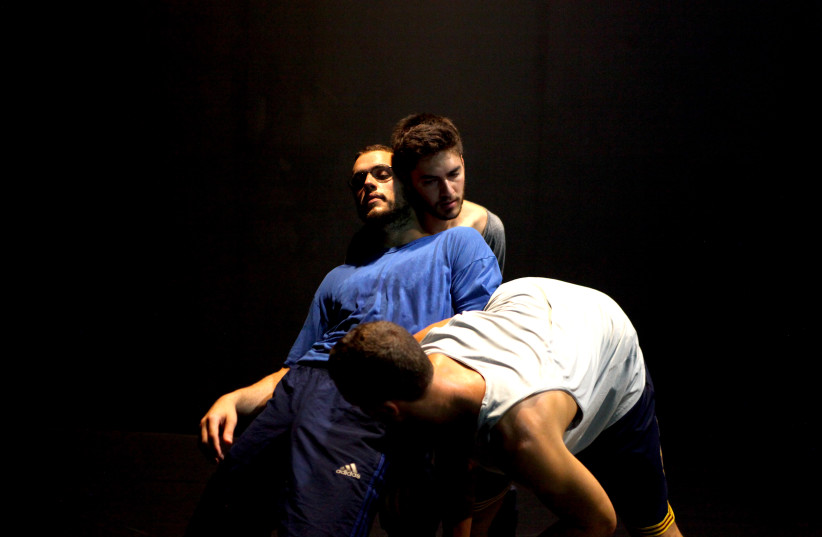In theaters around the world, a small lamp is left on at night. Called a ghost light, the lighting fixture is left on to illuminate the space for ghosts. Haunted houses, or theaters, are considered part and parcel of the profession, and the spirits present in them are welcomed and accommodated.
When Renana Raz began the process of a new work titled Ghost Light for Inbal Dance Theater, she was endowed with a hard drive upon which rested the company’s history.
As she pored over the archive, she could not help but feel that small theater perched at the far end of the Suzanne Dellal Center was home to spirits, one in particular.
“I started to watch it and felt that I was being sucked into a world, like you would get into a series, like The Crown, anxious to see what happened in the royal family. I felt that my work was tracing this woman, seeing what clues she left behind, how to take these things and put them back together, to understand what they mean today. I understood that this place isn’t just the works. One of the things that this place was built upon was the spirit of Sara Levi-Tanai,” says Raz. “I also understood that this place, Inbal, is carrying a fracture.”
Levi-Tanai founded Inbal Dance Theater in 1949. She carved out a space for the troupe, tooth and nail, over years of hard work, creation and insistence upon the necessity of folk dance and ethnic heritage in Israeli culture.
“People do not understand how subversive she was,” says Raz. “She was very interdisciplinary. I learned so much about her and I felt connected to her. I was drawn to this person. She was a teacher, she was interested in the connection between art and education and folklore, which I am very interested in as well.”
During her years at the helm of Inbal Dance Theater, Levi-Tanai created canonical works both in dance and song, which greatly influenced the trajectory of Israeli culture. She also experienced clashes from within and outside of the company. “She was very hard to deal with. The place got funding from the government and there were requirements, but she didn’t want to meet them. She wanted to work how she wanted to work,” explains Raz.
The fracture Raz refers to came when Levi-Tanai discovered she had been fired from her position as artistic director of Inbal. “She read in the paper that they were looking for a new artistic director and then a journalist called to get her response. That’s how she found out,” says Raz. “That moment started a break and put in motion a number of paths that have continued. The place needed to understand how to go on without her.”
Two days into the process, Raz experienced another fracture. “I broke my foot during a show. I wanted to see what this break could teach me.”
Together with the eight dancers of Inbal and with one foot out of commission, Raz picked up the breadcrumbs left behind by Levi-Tanai. “The piece follows the process we went through. In the beginning, we were trying to imitate what existed, to learn the folklore, culture, physicality, songs.”
As they progressed, Raz understood that while she grew up aware of the legacy of Levi-Tanai, the dancers did not.
“I talk to the dancers about folk dance and they have no idea what I’m talking about. I’m 20 years older than them. They don’t know not because they’re not interested but because they’re younger. Our generation understands what ‘us’ is and what ‘I’ means. They are a generation that grew up only on ‘I’. They don’t know what ‘us’ is. That’s their ethos.”
In spite of the generational gaps between the dancers and Levi-Tanai, Raz attempted to create bridges, to impart to the dancers, through choreography, the importance of what was accomplished at Inbal. “It is very hard to carry tradition or ethos on your shoulders. It gets heavier with the years. Here, ethos and tradition meet a body that lives in the present, and what does it mean for that body to carry it? It becomes a burden. You don’t want to put it in your body. And you have to because you work in a place that demands it. These questions are part of the work. What we do with tradition from one side gives a rich cultural context and on the other hand weighs us down,” says Raz.
The live actions are bolstered by footage from the hard drive Raz received at the onset of the process.
“I learned to edit video. It’s a composition in this work. How and how much are a composition of video, and it is material on stage. I felt I had to do it, to sit and feel the material,” Raz explains.
The result, Ghost Light, brings the tension between past and present, the desire to please others while pleasing oneself and the wish to be whole to the stage. Perhaps it will set some healing in motion for Inbal Dance Theater and, if nothing else, will shine a light for the house spirit.
Inbal Dance Theater will premiere Ghost Light by Renana Raz on May 18-20, 26 and 27. For more information visit www.inbal.org.il.

